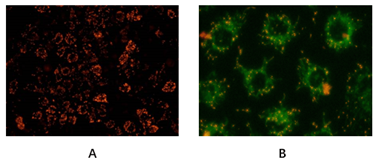Selection Strategy of Apoptosis Products- Early apoptosis
Apoptosis is a dynamic process, which involves a series of complex biochemical reactions, expression regulation of multiple genes, signal transduction, cascade reactions involving multiple enzymes and multiple signal pathways. The cell feels the corresponding apoptosis signal stimulation, and a series of control switches in the cell are turned on or off, and activation of various enzymes triggers a series of cascade reactions. Different external factors initiate apoptosis in different ways, resulting in different signal transduction.
Early apoptosis
Feature 1: eversion of lipid membrane inside
In normal cells, phosphatidylserine (PS) is only distributed on the inner side of the lipid bilayer of the cell membrane. In the early stage of cell apoptosis, PS turns from the inner side of the lipid membrane to the outer side. Annexin V is a calcium-dependent phospholipid binding protein with a molecular weight of 35-36kD, and has high affinity with PS. It binds to the cell membrane of early apoptotic cells through PS exposed on the outside of cells. Therefore Annexin V is a sensitive indicator to detect early apoptosis of cells. Usually, Annexin V is labeled with some fluorescent probes, which can simply and directly detect PS eversion, an important feature of apoptosis.
Product recommendation
| Product name | Cat# |
| Abbkine Annexin V-AbFluor™ 405 Apoptosis Detection Kit | KTA0001 |
| Abbkine Annexin V-AbFluor™ 488 Apoptosis Detection Kit | KTA0002 |
| Abbkine Annexin V-AbFluor™ 555 Apoptosis Detection Kit | KTA0003 |
| Abbkine Annexin V-AbFluor™ 647 Apoptosis Detection Kit | KTA0004 |
Product character
AbFlourTM series of characteristic fluorescent dyes (blue, green and red) patented by Abbkine label recombinant human Annexin V protein, and are matched with PI to introduce different fluorescence apoptosis detection kits, which are suitable for detection with fluorescence equipment such as flow cytometry and fluorescence microscope.
Feature 2: Mitochondrial membrane potential decreased
Normal mitochondrial membrane potential is the premise for maintaining mitochondrial oxidative phosphorylation and ATP production, and is necessary for maintaining mitochondrial function. The decline of mitochondrial membrane potential is a landmark event in the early stage of cell apoptosis. JC-1 is an ideal fluorescent probe widely used for detecting mitochondrial membrane potential. When mitochondrial membrane potential is high, JC-1 aggregates in the matrix of mitochondria to form polymers (J-aggregates). Red fluorescence can be generated (Ex/Em = 585/590). when the mitochondrial membrane potential is low, JC-1 cannot aggregate in the matrix of mitochondria. at this time, JC-1 is a monomer, which can generate green fluorescence (Ex/Em = 510/527 nm).
Product recommendation
| Product name | Cat# |
| Mitochondrial Membrane Potential Assay Kit (JC-1) | KTA4001 |
Product character
Abbkine Mitochondrial Membrane Potential Analysis Kit (JC-1) uses JC-1 as a fluorescent probe to rapidly and sensitively detect changes in mitochondrial membrane potential. This kit can very conveniently detect changes in mitochondrial membrane potential through changes in fluorescence color.












